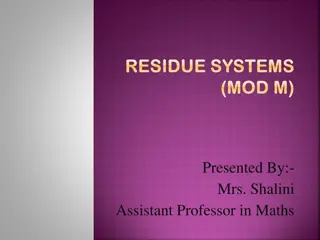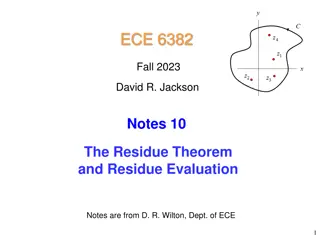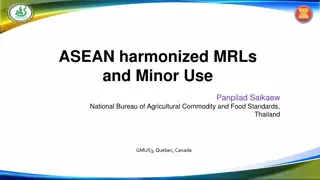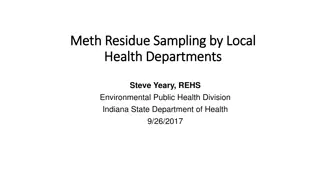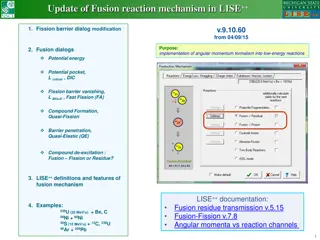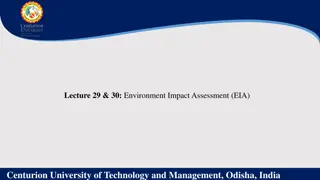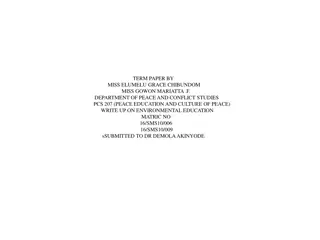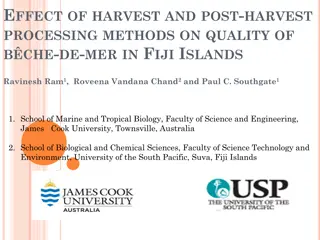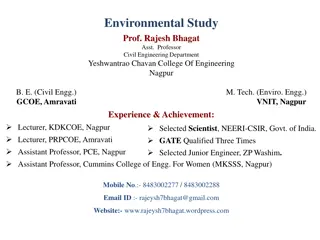Sustainable Processing of Bauxite Residue for Environmental Benefits
Sustainable Materials Processing Laboratory at the University of Toronto is focusing on innovative ways to neutralize acidic soil, treat mining wastes, and recover metals using bauxite residue. The research also delves into the properties of hot metal and steel, emphasizing steelmaking processes for better forming. Furthermore, the study explores the thermodynamic affinity for impurities, fluxes for de-sulfurization, and the recovery of iron value in the metal industry.
Download Presentation

Please find below an Image/Link to download the presentation.
The content on the website is provided AS IS for your information and personal use only. It may not be sold, licensed, or shared on other websites without obtaining consent from the author. Download presentation by click this link. If you encounter any issues during the download, it is possible that the publisher has removed the file from their server.
E N D
Presentation Transcript
Mansoor Barati A. Danaie, Y. Yang, R. Ravindran, A. McLean Sustainable Materials Processing Laboratory Department of Materials Science and Engineering University of Toronto Bauxite Residue 2018
Acidic soil neutralization Neutralization of mining wastes Construction materials Mine backfilling Metal recovery Waste water treatment http://www.intergeo.com Gary McNeish Linkedin https://opalicon.com http://www.everythingselectric.com 2
Hot Metal C: 4.3% Si: 0.2-1.0% S: 0.02-0.05% P: 0.03-0.1% Steel C: <0.2 % Si:<0.2 % S: <0.03 % P: <0.05 % Adapted from: https://www.thefabricator.com/article/metalsmaterials/understanding-steelmaking-for-better-forming 3
??2 High ? + ?2 = ?2 +1 Low pO2 2?2(? CO High T S2- O2- ??2 High [?] +5 2(?+3 3 2?2 = (??4 4? S O High pO2 Low T C [??] +5 2(?+3 3 2?2 = (???4 4? 4
High thermodynamic affinity for impurity High (basicity) Right pO2 (low for P, high for S) ??2 Fast reaction Melting and flowing properties Operation Slag handling, metal/slag separation, 5
Fe2O3 Al2O3 TiO2 SiO2 Na2O CaO LOI 37.5 19.4 8.6 9.4 6.6 6.2 12.2 Suitable for de-S Fluxes lime for better melting and fluidity Hot Metal C: 4.3% Si: 0.2-1.0% S: 0.02-0.05% P: 0.03-0.1% B=0.3 Recovery of its iron value Generating a slag suitable for cement feedstock Permanent fixation of BR! 6
flux flux metal metal Effect of FeO activity and temperature on phosphate capacity. Effect of basicity and temperature on sulphide capacity. Effect of basicity and temperature on phosphate capacity. 7
flux metal Effect of Al content of the flux on de-P of hot metal. Simultaneous de-S and de- P under controlled oxidizing conditions De-S of hot metal under reducing conditions. 8
50.2 Ni 9.6 Co 6.4 Mo 9.1 P 9.0 V 0.6 As 9.0 Fe 0.39 S LS1 + 13-16 wt.%CaO + 30-40 wt.%FeO LS1 + 20-25 wt.% CaO + 10-15 wt.% Al 11
42.7% Fe2O3 22.1% Al2O3 9.8% TiO2 10.7% SiO2 7.5% Na2O 7.1 % CaO 0.02 0.33 0.06 T = Fe: % S % Si % P 1378 C + 0.7% Refined Metal Calcined Red Mud (20 kg/t) Slag: 21.5 kg/t Lime (CaO) (6 kg/t) 1480 C 1378 C 4.5 0.6 0.5 0.05 0.06 T = % C % Si % Mn % S % P 1480 C Hot Metal 13
Al 42.7% Fe2O3 22.1% Al2O3 9.8% TiO2 10.7% SiO2 7.5% Na2O 7.1 % CaO (4 kg/t) 0.0003 0.55 0.06 % S % Si % P 1445 C + 0.7% Calcined Red Mud (20 kg/t) Refined Metal T = Fe: Slag: 27.4 kg/t Lime (CaO) (11 kg/t) 1480 C 1445C 4.5 0.6 0.5 0.05 0.06 T = % C % Si % Mn % S % P 1480 C Hot Metal 14
O2 42.7% Fe2O3 22.1% Al2O3 9.8% TiO2 10.7% SiO2 7.5% Na2O 7.1 % CaO (3.5 Nm3/t) 0.02 0.22 0.06 T = Fe: % S % Si % P 1440 C + 0.7% Calcined Red Mud (20 kg/t) Refined Metal Slag: 29.2 kg/t Lime (CaO) (11 kg/t) 1480 C 1440C 4.5 0.6 0.5 0.05 0.06 T = % C % Si % Mn % S % P 1480 C Hot Metal 15
+ Consuming 12-20 Mt/y Red Mud Recovery of 3.5-7 Mt/y of Fe Reduced need for de-Si & ladle de-S Producing 12-18 Mt/y slag suitable for cement (C:S:A=1:1:0.5) Unknowns Transportation and calcination costs Effect of Na on refractory and off-gas 16
BR-based fluxes with addition of lime, Al or O2 proved to be very effective in removal of S from Ni-Co alloy and hot metal. Lowest melting point of flux is achieved with B =1.5-2.0 Treatment of hot metal with BR would result in: Consuming 12-20 Mt/y Red Mud Recovery of 3.5-7 Mt/y of Fe Reduced need for de-Si & ladle de-S Producing 12-18 Mt/y slag suitable for cement (C:S:A=1:1:0.5) Unknowns Transportation and calcination costs Effect of Na on refractory and off-gas 17
+ Consuming 12-20 Mt/y Red Mud Recovery of 3.5-7 Mt/y of Fe Reduced need for de-Si & ladle de-S Producing 12-18 Mt/y slag suitable for cement (C:S:A=1:1:0.5) Unknowns Transportation and calcination costs Effect of Na on refractory and off-gas 19
https://cen.acs.org/articles/92/i8/Making-Red-Mud.html A review of the alumina recovery from coal fly ash, with a focus in China, Z.T. Yao et al. / Fuel 120 (2014) 74 85 20
Temperature drop due to iron reduction Increasing iron yield. Composition of flux after iron removal is even more attractive. Typical consumptions and prospects of using red mud for flux making (comparing tonnages) 21
Flux Fe2O3 10.0 Al2O3 4.78 TiO2 2.8 SiO2 14.2 Na2O 6.0 CaO LOI LS1 29.7 30 LS2 14.3 6.9 4.1 20.3 8.6 42.6 RM 45.1 19.6 7.1 11.0 9.4 3.9 22


